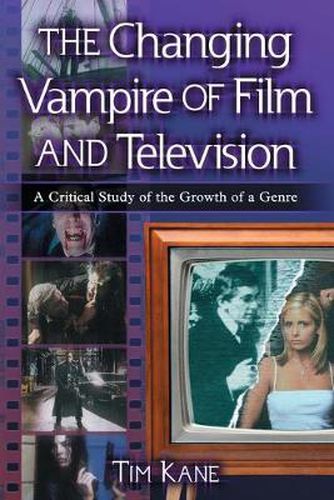Readings Newsletter
Become a Readings Member to make your shopping experience even easier.
Sign in or sign up for free!
You’re not far away from qualifying for FREE standard shipping within Australia
You’ve qualified for FREE standard shipping within Australia
The cart is loading…






This title is printed to order. This book may have been self-published. If so, we cannot guarantee the quality of the content. In the main most books will have gone through the editing process however some may not. We therefore suggest that you be aware of this before ordering this book. If in doubt check either the author or publisher’s details as we are unable to accept any returns unless they are faulty. Please contact us if you have any questions.
Vampires have been a fixture of film since Bela Lugosi brought Bram Stoker’s
Dracula
to life on the big screen in 1931. Over the decades the genre has been far from static, as vampire narratives changed and evolved with the appetites of their viewing public. First depicted as formally dressed villains, vampires would later be portrayed as supernatural beings with some human characteristics, and still later as sympathetic figures. Focusing on 19 representative films and television productions, this critical study tracks the evolutionary changes of the screen vampire. It explores the factors that cause a genre to change and examines the alternating cycles of audience expectation. The author identifies three distinct modes of depiction: the Malignant Cycle (1931-1948), comprised primarily of the Universal films; the Erotic Cycle (1957-1985), which encompasses Hammer films and popular television shows such as Dark Shadows; and the Sympathetic Cycle (1987 - present) including recent offerings such as
The Lost Boys ,
Interview with the Vampire
and
Buffy the Vampire Slayer . Each film is evaluated in seven key areas, including the act of the vampire biting the victim; process of the victim’s infection; physical appearance and demeanor of the vampire and the vampire expert; and the eventual destruction of the vampire. Appendices provide a complete synopsis of films examined including country of origin, theatrical release, director, writer(s), cast and plot summary.
$9.00 standard shipping within Australia
FREE standard shipping within Australia for orders over $100.00
Express & International shipping calculated at checkout
This title is printed to order. This book may have been self-published. If so, we cannot guarantee the quality of the content. In the main most books will have gone through the editing process however some may not. We therefore suggest that you be aware of this before ordering this book. If in doubt check either the author or publisher’s details as we are unable to accept any returns unless they are faulty. Please contact us if you have any questions.
Vampires have been a fixture of film since Bela Lugosi brought Bram Stoker’s
Dracula
to life on the big screen in 1931. Over the decades the genre has been far from static, as vampire narratives changed and evolved with the appetites of their viewing public. First depicted as formally dressed villains, vampires would later be portrayed as supernatural beings with some human characteristics, and still later as sympathetic figures. Focusing on 19 representative films and television productions, this critical study tracks the evolutionary changes of the screen vampire. It explores the factors that cause a genre to change and examines the alternating cycles of audience expectation. The author identifies three distinct modes of depiction: the Malignant Cycle (1931-1948), comprised primarily of the Universal films; the Erotic Cycle (1957-1985), which encompasses Hammer films and popular television shows such as Dark Shadows; and the Sympathetic Cycle (1987 - present) including recent offerings such as
The Lost Boys ,
Interview with the Vampire
and
Buffy the Vampire Slayer . Each film is evaluated in seven key areas, including the act of the vampire biting the victim; process of the victim’s infection; physical appearance and demeanor of the vampire and the vampire expert; and the eventual destruction of the vampire. Appendices provide a complete synopsis of films examined including country of origin, theatrical release, director, writer(s), cast and plot summary.